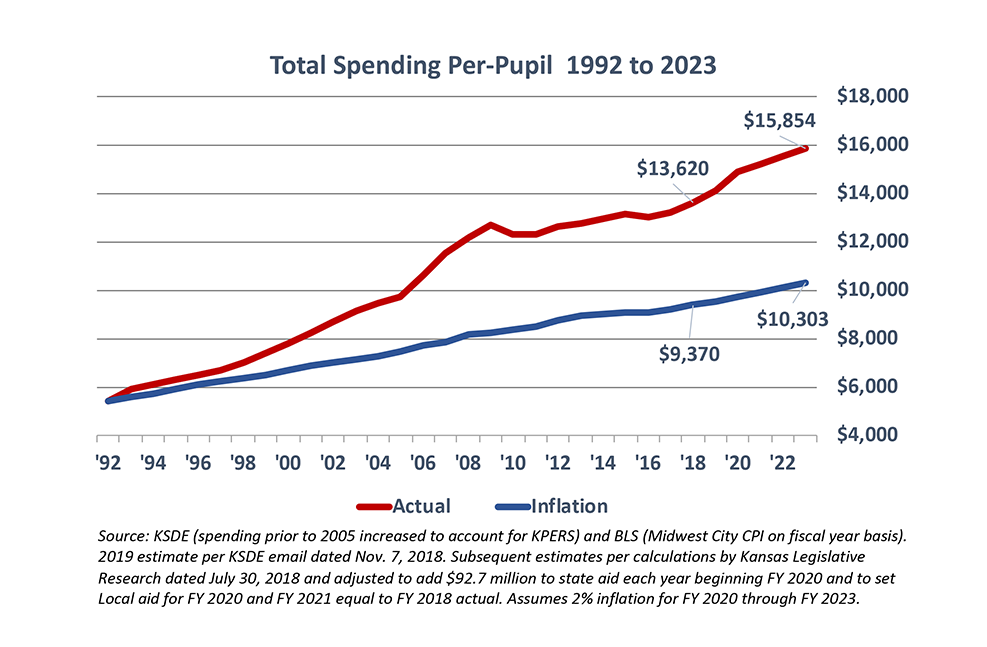The average 2021 ACT scores in Kansas declined for the fifth consecutive year, to 19.9, and the decline in college readiness to 21% marks the sixth consecutive drop. Kansas is again below the national average on both measurements
Only 21% of Kansas graduates did well enough to be considered college-ready in English, 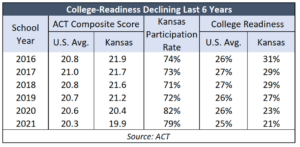 Reading, Math, and Science on the 2021 ACT. That’s down from 31% in 2016 and for the second time, below the national average, which is 25%.
Reading, Math, and Science on the 2021 ACT. That’s down from 31% in 2016 and for the second time, below the national average, which is 25%.
State average scores are skewed by two major factors – demographic differences among the states and participation rates (the percentage of students taking the ACT in each state).
Participation rates affect average state scores because, in states where the ACT isn’t mandatory, only students planning to attend college are likely to take the test, and that will artificially increase average state scores over states where the ACT is mandatory for all students. Some of last year’s decline is likely attributable to higher participation, but not this year. Participation in Kansas dropped from 82% to 79%.
Some states improved in 2021
The COVID pandemic will undoubtedly be blamed for the decline in Kansas, but some states in the region show improvement.
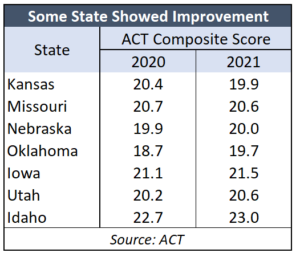 Nebraska, Oklahoma, and Iowa each have higher state average composite scores than a year ago. Utah and Idaho also did better.
Nebraska, Oklahoma, and Iowa each have higher state average composite scores than a year ago. Utah and Idaho also did better.
Missouri dropped 20.7 to 20.6 but that is a much smaller decline than in Kansas.
House Education Chair Kristey Williams (R-Augusta) says school districts must ensure that they are prioritizing resources to improve outcomes.
“This provides more evidence of what we already believed to be true — without in-person learning, or with excessive interruptions, student achievement would decline. With over $1.5 billion of federal money flowing into our schools — districts should be able to target learning loss and make huge gains in the upcoming year. If gains are not made in state assessments and the ACT, then school boards will need to critically evaluate how money is being spent and shift resources to where kids need them most — in the classroom.”
Wide achievement gaps for students of color
Large achievement gaps between white students and students of color, and also between low-income students and everyone else, also skew state average scores. States with higher portions of minorities and low-income kids will appear to have lower average scores.
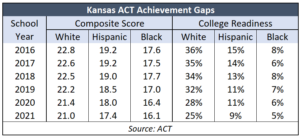 ACT doesn’t publish income-based demographics but the achievement gaps in Kansas between White, Hispanic, and Black students are significant and persistent. Only 5% of Black students are college-ready compared to 9% for Hispanic students and 25% for White students.
ACT doesn’t publish income-based demographics but the achievement gaps in Kansas between White, Hispanic, and Black students are significant and persistent. Only 5% of Black students are college-ready compared to 9% for Hispanic students and 25% for White students.
College readiness has consistently declined since 2016 for each demographic cohort. White students’ college readiness fell from 36% to 25%, Hispanic students from 15% to 9%, and Black students dropped from 8% to 5%.
Each demographic cohort’s composite score declined along with the drop in college readiness and is now below 2003 levels.
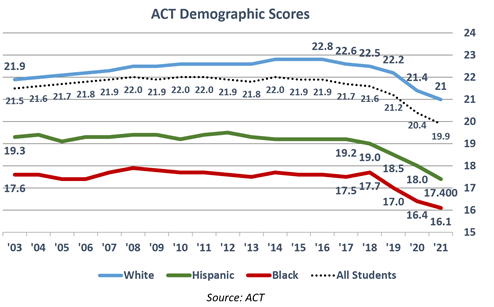
And while many school officials say more spending is needed to improve achievement, the declines in composite scores and college readiness occurred while spending significantly increased.
Per-student spending has increased from $8,694 in 2002 to more than $16,000 last year and is now 33% above inflation-increased spending since 2002.

CRT and SEL rise while academic achievement declines
It may not be a coincidence that academic achievement has noticeably declined since the Kansas Department of Education de-emphasized measuring achievement in 2017 and placed significant attention on Social Emotional Learning and so-called soft skills. Most recently, some school districts have begun pushing critical race theory on students and staff, albeit under the guise of diversity, equity, and inclusion.
KSDE evaluates now school districts based on these measures:
- Academically prepared for postsecondary
- High school graduation
- Postsecondary success
- Social-emotional growth
- Kindergarten readiness
- Individual plan of study
- Civic engagement
Only ‘preparation for postsecondary’ measures actual achievement growth. High school graduation rates are pretty meaningless when many diplomas are given to students who are below grade level. Individual plans of study have value, but that is a tactic more so than a measurement of achievement.


